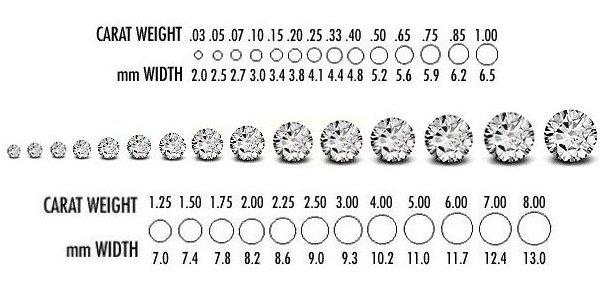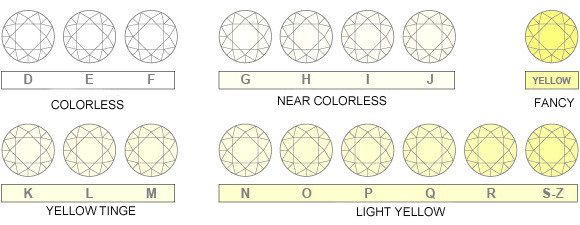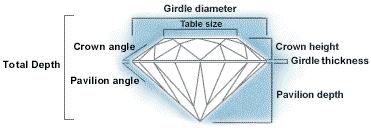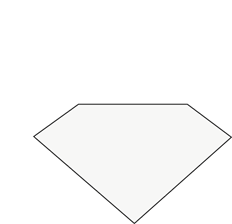The concept of 4 Cs is used internationally to group specific characteristics of
diamonds to determine the quality of a gemstone.
CARAT
Diamonds and other gemstones are weighed in metric carats: one carat is equal to
0.2 grams, about the same weight as a paperclip. (Don’t confuse carat with karat,
as in “18K gold,” which refers to gold purity.)
The weight or size of a diamond is measured in carats (ct.). A carat is 0.2 grams
and there are 100 points (or 200 milligrams) per carat. With an accuracy of 1/100,000
ct.

How did the carat system start?
The carat, the standard unit of weight for diamonds and other gemstones, takes its
name from the carob seed. Because these small seeds had a fairly uniform weight,
early gem traders used them as counterweights in their balance scales. The modern
metric carat, equal to 0.2 grams, was adopted by the United States in 1913 and other
countries soon after. Today, a carat weighs exactly the same in every corner of
the world.
COLOR
Diamond color is all about what you can’t see. Diamonds are valued by how closely
they approach colorlessness – the less color, the higher their value.
(The exception to this is fancy-color diamonds, such as pinks and blues, which lie
outside this color range.)

Most diamonds of gem quality vary in shade from colorless to yellow. To determine
the correct color, all submitted diamonds are compared to an internationally accepted
master set of stones, the color of which ranges from D, or colorless (the most sought
after) to Z, the yellowest. Other colors occur in diamonds such as brown, orange,
pink, blue, etc.
The most intense of these shades are determined as "Fancy" colors and referenced
on the IGI Diamond Report.

CLARITY
Because diamonds formed deep within the earth, under extreme heat and pressure,
they often contain unique birthmarks, either internal (inclusions) or external (blemishes).
Every diamond is unique. None is absolutely perfect under 10× magnification, though
some come close. Known as Flawless diamonds, these are exceptionally rare. Most
jewelers have never even seen one.

Flawless (FL) - No inclusions or blemishes are visible to a skilled grader using
10× magnification
Internally Flawless (IF) - No inclusions and only blemishes are visible to a skilled
grader using 10× magnification
Very, Very Slightly Included (VVS1 and VVS2) - Inclusions are difficult for a skilled
grader to see under 10× magnification
Very Slightly Included (VS1 and VS2) - Inclusions are clearly visible under 10×
magnification but can be characterized as minor
Slightly Included (SI1 and SI2) - Inclusions are noticeable to a skilled grader
using 10× magnification
Included (I1, I2, and I3) - Inclusions are obvious under 10× magnification and may
affect transparency and brilliance
In order to grade the clarity of a diamond, it is necessary to observe the number
and nature of any internal characteristics in the stone as well as their size and
position. This Diamond Clarity Grading is carried out using a loupe 10x under the
experienced eye of laboratory gemologists. A diamond is said to be "Internally Flawless"
when it presents no internal defects under 10x magnification.
CUT
Cut is the factor that fuels a diamond’s fire, sparkle and brilliance.
The traditional 58 facets in a round brilliant diamond, each precisely cut and defined,
are as small as two millimeters in diameter. But without this precision, a diamond
wouldn’t be nearly as beautiful. The allure of a particular diamond depends more
on cut than anything else.
An understanding of diamond cut begins with the shape of a diamond. The standard
round brilliant is the shape used in most diamond jewelry. All others are known
as fancy shapes. Traditional fancy shapes include the marquise, pear, oval and emerald
cuts. Hearts, cushions, triangles and a variety of others are also gaining popularity
in diamond jewelry.

As a value factor, though, cut refers to a diamond’s proportions, symmetry and polish.
For example, look at a side view of the standard round brilliant. The major components,
from top to bottom, are the crown, girdle and pavilion. A round brilliant cut diamond
has 57 or 58 facets, the 58th being a tiny flat facet at the bottom of the pavilion
that’s known as the culet. The large, flat facet on the top is the table. The proportions
of a diamond refer to the relationships between table size, crown angle and pavilion
depth. A wide range of proportion combinations are possible, and these ultimately
affect the stone’s interaction with light.

How a diamond has been cut, polished, and to what proportions and symmetry, are
of utmost importance since these factors determine the life, brilliance and dispersion
of the diamond. If these cutting factors fall below standard, the appearance of
the diamond will be adversely affected.
|